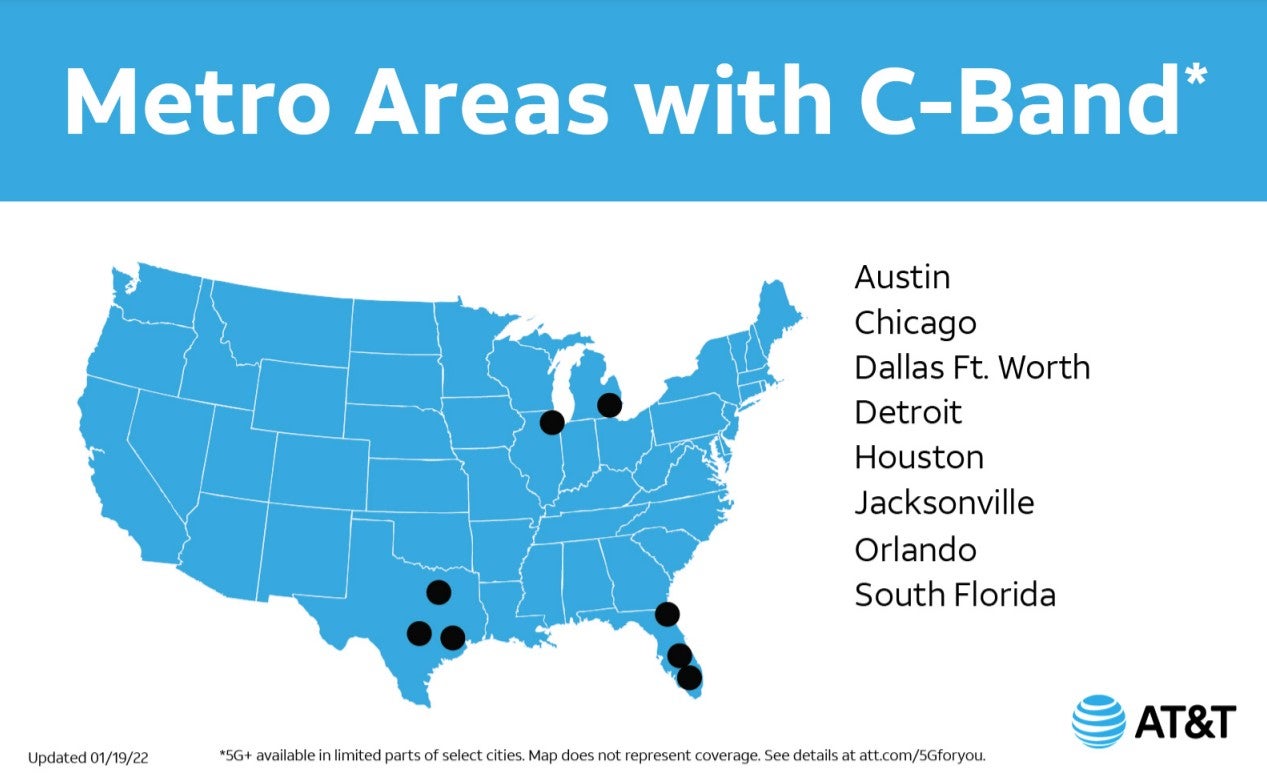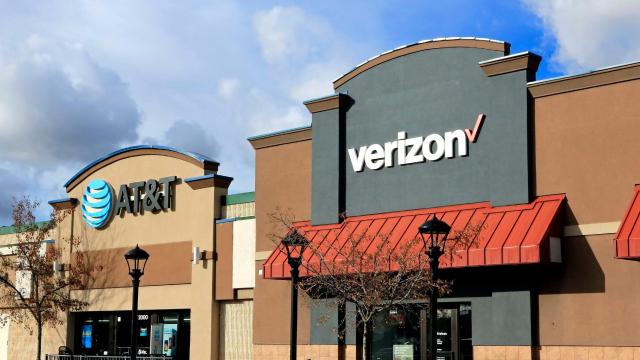AT&T and Verizon activated their C-band 5G spectrum today, a move that marks the long-awaited arrival of true 5G speeds for hundreds of millions of customers.
Both carriers have invested billions of dollars securing the spectrum and deploying the equipment needed to activate a 5G network that could deliver considerably faster speeds than 4G LTE across wide areas of the country. While the investment could pay off in the long run, getting to this point has been turbulent. AT&T and Verizon have been forced to delay the rollout multiple times due to concerns from the Federal Aviation Administration (FAA) and major airlines that the network could lead to “catastrophic disruption” to flights across the country.
Even after several delays, the carriers said on Tuesday that they would hold off on launching the new mid-band 5G service near airports until the potential issues are resolved. At the heart of the problem is that C-band 5G operates at the 3.7-4.2 GHz frequencies, which the FAA fears are too close to that of aeroplane equipment (4.2-44 GHz) and could therefore prevent communication with radio altimeters on the ground.
Despite arguing that more than 40 countries have deployed 5G base stations near airports without any problems, AT&T and Verizon agreed to create buffer zones, areas where the C-band transmitters are disabled, at 50 airports for six months after deployment to, as the FCC states, “minimise potential 5G interference with sensitive aircraft instruments used in low-visibility landings.” The carriers still aren’t happy with that interim solution, and you can expect them to flip the switch on their mid-band networks at airports the moment they get the green light.
“The Federal Aviation Administration (FAA) and our nation’s airlines have not been able to fully resolve navigating 5G around airports, despite it being safe and fully operational in more than 40 other countries,” Verizon said in a statement.
Where You Can Use the New 5G Networks
With certain safeguards for airline travel temporarily in place, we can focus, at least for now, on what this major rollout means for customers. Prior to turning on its C-band network, Verizon relied primarily on mmWave, an extremely fast (greater than 1 Gbps speeds) version of 5G but one with severely limited range and sensitivity to physical obstructions. Good luck getting mmWave in your home.
Verizon’s 5G network was only available on select streets in certain parts of a few major U.S. cities, and even if you were lucky enough to be standing in the right spot, data speeds were wildly inconsistent. To make matters worse, the other available flavour of Verizon 5G prior to today, “5G Nationwide,” is widely mocked for being slower than 4G LTE.
Verizon’s new C-band, or mid-band, 5G fills a gaping hole in the network’s coverage. Now, customers living in medium or large markets should see “5G Ultra-Wideband” (or 5G UW) on their phones or tablets more consistently, and not only in dense urban areas. Sure enough, Verizon users are posting speed tests to Reddit showing how download rates regularly top 500 Mbps and occasionally cross the 1 Gbps line.

AT&T similarly flipped the switch on its mid-band network, though on a much smaller scale. Where Verizon promises to cover 90 million customers across 1,700 cities this month, AT&T is rolling out C-band to limited parts of eight metro areas, including Detroit, Chicago, Austin, Dallas-Fort Worth, Houston, Jacksonville, Orlando, and “south Florida.” I tried testing the network in Austin, but the 3.9 Mbps download speeds I clocked in my home suggest the rollout hasn’t hit central parts of the city.
Like Verizon, AT&T had relied on a mix of fast but short-range mmWave and sluggish sub-6Ghz spectrum. With C-band, it expands its “5G+” network to more customers while bringing them noticeably faster speeds.
“It will expand rapidly as our thoughtful and efficient deployment ramps up throughout the year,” Chris Sambar, AT&T’s executive vice president of technology operations, said in a blog post. “With 17 C-Band-capable devices already available online and in our stores, you can start seeing those speeds today.”
As Sambar suggested, only those with compatible devices will benefit from these expanded networks. Newer devices like the iPhone 12 and later, Google’s Pixel 6, and Samsung’s Galaxy S21 carry the modems required to connect to these networks, but older devices will be limited to either 4G LTE or sub-6Ghz 5G. Verizon says every phone it releases from now on will support C-band 5G and it expects there to be more than 20 compatible phones by the end of the year.
What This Means for 5G
So why C-band, and why now? 5G has been hyped to death for the past decade, but when it arrived in the U.S., it didn’t exactly change the way we experience the internet in the way carriers had promised. Part of the problem is the use of high and low bands, the limitations of which were described above. This C-band, or mid-band 5G, could be the golden ticket we’ve been waiting for. In fact, these bands are often referred to as being the “Goldilocks” of frequencies because they can carry enough data for fast download speeds and, rather crucially, can travel long distances while not breaking down at the sight of a physical wall.
It’s this rare best of both worlds combination that raised the government auction price for these wavelengths to astronomical figures. Verizon spent $US45.5 ($63) billion last year while AT&T put down $US23 ($32) billion — and only for the rights to use those spectrums. Add to that many more billions to deploy and it’s clear these two carriers see C-band as being the bedrock of their networks going forward.
“It’s excellent right down the middle. You have a great amount of bandwidth, it propagates well and it goes through buildings,” Verizon CTO Kyle Malady told CNBC. “I give credit to the U.S. government, they put a lot of spectrum up for auction. This rarely comes along. And that’s why we were so aggressive in the auction to get this.”
Now What?
If you’re an AT&T or Verizon customer in a region now, or soon to be, blanketed by C-band 5G, then you’ll want to look for the 5GUW (Verizon) or 5G+ (AT&T) symbols on your phone. As a reminder, not every 5G phone will benefit — your device needs to specifically support C-band 5G.
It’s also worth noting that AT&T and Verizon are, rather refreshingly, not making creating yet another confusing label for this new spectrum of 5G. But since C-band falls under existing umbrellas, it may be difficult to tell whether you’re using the new spectrum or mmWave 5G. If you have a stable connection over a far distance (not only a few blocks), then it’s safe to assume you’re on C-band.
The last thing you’ll need is to subscribe to the right plan. For Verizon, that means any of the following: 5G Get More, 5G Play More, and 5G Do More, while any of AT&T’s three unlimited plan options will get you 5G support. Of course, these plans are always in flux, so don’t be surprised if, by the time you read this (even if that’s later today), things have changed. The good news is existing customers don’t need to do anything or pay any more than they did before to enjoy what should be considerably faster network speeds.
Editor’s Note: Release dates within this article are based in the U.S., but will be updated with local Australian dates as soon as we know more.
